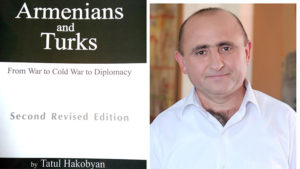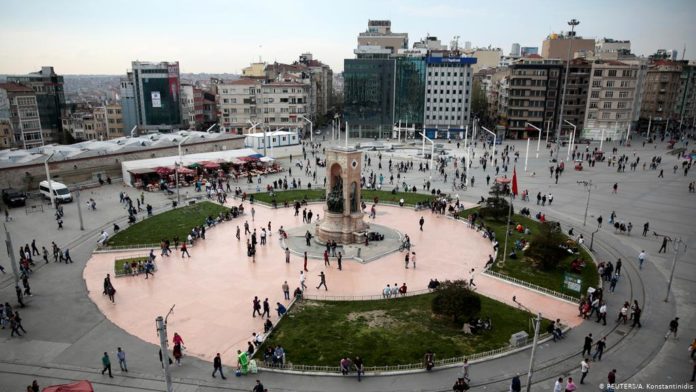On the morning of April 24, 1965, several dozen Turkish Armenians led by Berj Turan, former member of Turkish Parliament, placed a wreath in front of Mustafa Kemal Atatürk’s statue in Taksim Square in central Istanbul.
The Turkish press widely referred to the 1965 Armenian events. In its April 8 publication, Hurriyet wrote, “On April 24, a new international struggle will be waged against Turkey before the public opinion of the whole world. Led by the Orthodox Church in Beirut, mourning events in memory of the ‘massacred Armenians’ will take place Paris, New York, Athens, London, and in different cities in South America to commemorate the victims and ‘to get across Turkey’s atrocities to all’. These ceremonies, speeches, and published brochures will be disseminated by radio stations and on television.”
The Turkish press attached serious importance to these ceremonies and constantly wrote articles about April 24 by sending its correspondents to Beirut. Hurriyet published short interviews with renowned Armenians in Istanbul, placing them under the title, “Our fatherland is Turkey, our flag is the Turkish flag, we are connected with this country just like any Turk”. Allegedly, the head of Armenian Catholics said, “The meetings planned in Beirut will not help with anything.” According to Berj Turan, “The Greeks are trying to provoke our compatriots against Turkey. I do not think that through this they will manage to disturb the peace of 70,000 Armenians living in Turkey.”
Turkey’s Armenian Patriarch Archbishop Shnorhk Galustian’s words were measured: “To remember the dead is everyone’s right and moral responsibility. However, manifestations of respect should not instill enmity in the hearts of nations.”
The Turkish press widely referred to the Armenian rallies organised in different parts of the world. On that occasion, Prime Minister Ali Suat Hayri Ürgüplü gave a speech in parliament declaring that, in several countries, extremist Armenian groups had organised demonstrations and rallies, but the organisers failed to ensure the desired number of participants. The prime minister condemned the Greeks, claiming they were behind those protests. “The aim of the provocateurs is to falsify historical facts fifty years on and to conduct propaganda against Turkey. We have explained to interested states that the Armenian issue has nothing to do with Turkey and it is not right to falsify history. Our reasonable Armenian compatriots did not participate in those events. They even condemned the rallies abroad by placing a wreath on Atatürk’s monument on April 24, the day of the rally.”
45 years later, on April 24, 2010, some tens of human rights defenders staged a demonstration at Istanbul’s Haydarpaşa Train Station. The first group of Armenian intellectuals was sent to death marches from that spot 95 years earlier, in 1915. The demonstrators raised photos of the exiled Armenian writers who were later savagely murdered. Turkish and Kurdish human rights defenders and intellectuals staged another memorial at Istanbul’s main Taksim Square in honor of the 1915 victims.
This was an unusual event for Turkey. Some one thousand Turkish police protected the demonstrators from attacks by Turkish nationalists. The nationalists declared that Armenians themselves had massacred Turks. One day later, representatives of the ultranationalist Büyük Birlik Partisi, the Great Union Party, burnt the Armenian tricolour.
One year later, on the same day, memorial events took place in Istanbul, Ankara, Diyarbakır, and Bodrum. The participants condemned what took place in 1915 and subsequent years, describing the events as “a crime against humanity” and “a great calamity”. They asked for forgiveness from Armenians. However, in the main, they avoided the term “genocide.” Some 400 gathered in Taksim Square. With Armenian music playing in the background, they all fell to their knees and observed a minute of silence for the 1915 victims. Speeches were made and the names of the 250 Armenian intellectuals rounded up and murdered were read out.1
A memorial was also held at the Sultan Ahmet historic place. Turkish intellectuals held aloft posters saying that, in 1915, the museum was a jail where Armenian intellectuals were held before being sent on to their death marches. Turkish nationalists responded with two rallies. Scores of Turks in the vicinity of Taksim carried banners reading “Long live our new liberation struggle against the second Treaty of Sèvres”. Then members of the extreme nationalist Grey Wolves group, known in Turkish as Bozkurt, carried Azerbaijani flags and marched down Istiklal Avenue,a main thoroughfare, chanting slogans that genocide claims were imperialist lies.
These commemorations of 1915 in Turkey, regardless of the number of participants or what they said, was unprecedented. Every year, since 2010, several hundred Turks, Kurd, and Turkish Armenians, commemorate the Armenian Genocide day.
Tatul Hakobyan
This piece is from Tatul Hakobyan’s book – ARMENAINS and TURKS














